Case Study—Spiking Neural Network Hardware System for Structural Health Monitoring
Abstract
1. Introduction
2. Related Works
3. SHM System Based on SNN
3.1. System Architecture
3.2. Feature Extraction
3.3. Structure Damage Classification
4. Experiments
4.1. Dataset
4.2. Feature Extraction
4.3. SHM Classification Results
4.3.1. K-Means
4.3.2. ANN
4.3.3. NeuCube
4.3.4. Customized SNN
4.3.5. Discussions
5. Conclusions
Author Contributions
Funding
Conflicts of Interest
References
- Moaveni, B.; He, X.; Conte, J.P.; Restrepo, J.I.; Panagiotou, M. System identification study of a 7-story full-scale building slice tested on the UCSD-NEES shake table. J. Struct. Eng. 2011, 137. [Google Scholar] [CrossRef]
- Park, S.W.; Park, H.S.; Kim, J.H.; Adeli, H. 3D displacement measurement model for health monitoring of structures using a motion capture system. Meas. J. Int. Meas. Confed. 2015, 59, 352–362. [Google Scholar] [CrossRef]
- Hernandez, E.; Roohi, M.; Rosowsky, D. Estimation of element-by-element demand-to-capacity ratios in instrumented SMRF buildings using measured seismic response. Earthq. Eng. Struct. Dyn. 2018, 47, 2561–2578. [Google Scholar] [CrossRef]
- Hsu, T.Y.; Yin, R.C.; Wu, Y.M. Evaluating post-earthquake building safety using economical MEMS seismometers. Sensors 2018, 18, 1437. [Google Scholar] [CrossRef]
- Abdo, M. Structural Health Monitoring, History, Applications and Future. A Review Book; Open Science Publishers: New York, NY, USA, 2014; ISBN 978-1-941926-07-9. [Google Scholar]
- Liu, J.; McDaid, L.J.; Harkin, J.; Karim, S.; Johnson, A.P.; Millard, A.G.; Hilder, J.; Halliday, D.M.; Tyrrell, A.M.; Timmis, J. Exploring Self-Repair in a Coupled Spiking Astrocyte Neural Network. IEEE Trans. Neural Networks Learn. Syst. 2019, 30, 865–875. [Google Scholar] [CrossRef] [PubMed]
- Liu, J.; McDaid, L.J.; Harkin, J.; Wade, J.J.; Karim, S.; Johnson, A.P.; Millard, A.G.; Halliday, D.M.; Tyrrell, A.M.; Timmis, J. Self-repairing learning rule for spiking astrocyte-neuron networks. In Proceedings of the Lecture Notes in Computer Science (Including Subseries Lecture Notes in Artificial Intelligence and Lecture Notes in Bioinformatics), Guangzhou, China, 14–18 November 2017. [Google Scholar]
- Lee, J.H.; Delbruck, T.; Pfeiffer, M. Training deep spiking neural networks using backpropagation. Front. Neurosci. 2016. [Google Scholar] [CrossRef]
- Roy, K.; Jaiswal, A.; Panda, P. Towards spike-based machine intelligence with neuromorphic computing. Nature 2019. [Google Scholar] [CrossRef]
- Bull, L.A.; Rogers, T.J.; Wickramarachchi, C.; Cross, E.J.; Worden, K.; Dervilis, N. Probabilistic active learning: An online framework for structural health monitoring. Mech. Syst. Signal Process. 2019, 134, 106294. [Google Scholar] [CrossRef]
- Eftekhar Azam, S.; Rageh, A.; Linzell, D. Damage detection in structural systems utilizing artificial neural networks and proper orthogonal decomposition. Struct. Control Health Monit. 2019. [Google Scholar] [CrossRef]
- Worden, K.; Manson, G. The application of machine learning to structural health monitoring. Philos. Trans. R. Soc. A Math. Phys. Eng. Sci. 2007, 365, 515–537. [Google Scholar] [CrossRef]
- Amezquita-Sanchez, J.P.; Adeli, H. Feature extraction and classification techniques for health monitoring of structures. Sci. Iran. 2015, 22, 1931–1940. [Google Scholar]
- Bouzenad, A.E.; El Mountassir, M.; Yaacoubi, S.; Dahmene, F.; Koabaz, M.; Buchheit, L.; Ke, W. A semi-supervised based k-means algorithm for optimal guided waves structural health monitoring: A case study. Inventions 2019, 4, 17. [Google Scholar] [CrossRef]
- Amezquita-Sanchez, J.P.; Valtierra-Rodriguez, M.; Adeli, H. Wireless smart sensors for monitoring the health condition of civil infrastructure. Sci. Iran. 2018, 25, 2913–2925. [Google Scholar]
- Karayannis, C.G.; Chalioris, C.E.; Angeli, G.M.; Papadopoulos, N.A.; Favvata, M.J.; Providakis, C.P. Experimental damage evaluation of reinforced concrete steel bars using piezoelectric sensors. Constr. Build. Mater. 2016. [Google Scholar] [CrossRef]
- Oh, B.K.; Kim, K.J.; Kim, Y.; Park, H.S.; Adeli, H. Evolutionary learning based sustainable strain sensing model for structural health monitoring of high-rise buildings. Appl. Soft Comput. J. 2017. [Google Scholar] [CrossRef]
- Jang, S.; Jo, H.; Cho, S.; Mechitov, K.; Rice, J.A.; Sim, S.H.; Jung, H.J.; Yun, C.B.; Spencer, B.F.; Agha, G. Structural health monitoring of a cable-stayed bridge using smart sensor technology: Deployment and evaluation. Smart Struct. Syst. 2010, 6, 439–459. [Google Scholar] [CrossRef]
- Wang, J.F.; Xu, Z.Y.; Fan, X.L.; Lin, J.P. Thermal Effects on Curved Steel Box Girder Bridges and Their Countermeasures. J. Perform. Constr. Facil. 2017, 31. [Google Scholar] [CrossRef]
- Mesquita, E.; Arêde, A.; Pinto, N.; Antunes, P.; Varum, H. Long-term monitoring of a damaged historic structure using a wireless sensor network. Eng. Struct. 2018, 161, 108–117. [Google Scholar] [CrossRef]
- Notley, S.; Magdon-Ismail, M. Examining the Use of Neural Networks for Feature Extraction: A Comparative Analysis using Deep Learning, Support Vector Machines and K-Nearest Neighbor Classifiers. arXiv 2018, arXiv:1805.02294. [Google Scholar]
- Zhang, Y.Z.; Hu, X.F.; Zhou, Y.; Duan, S.K. A Novel Reinforcement Learning Algorithm Based on Multilayer Memristive Spiking Neural Network with Applications. Zidonghua Xuebao/Acta Autom. Sin. 2019. [Google Scholar] [CrossRef]
- Naeem, M.; McDaid, L.J.; Harkin, J.; Wade, J.J.; Marsland, J. On the Role of Astroglial Syncytia in Self-Repairing Spiking Neural Networks. IEEE Trans. Neural Networks Learn. Syst. 2015. [Google Scholar] [CrossRef] [PubMed]
- Gonzalez, I.; Khouri, E.; Gentile, C.; Karoumi, R. Novel AI-based railway SHM, its behaviour on simulated data versus field deployment. In Proceedings of the 7th Asia-Pacific Workshop on Structural Health Monitoring (APWSHM), Hong Kong, China, 12–15 November 2018. [Google Scholar]
- Medhi, M.; Dandautiya, A.; Raheja, J.L. Real-Time Video Surveillance Based Structural Health Monitoring of Civil Structures Using Artificial Neural Network. J. Nondestruct. Eval. 2019, 38, 63. [Google Scholar] [CrossRef]
- De Oliveira, M.A.; Araujo, N.V.S.; da Silva, R.N.; da Silva, T.I.; Epaarachchi, J. Use of Savitzky-Golay filter for performances improvement of SHM systems based on neural networks and distributed PZT sensors. Sensors 2018, 18, 152. [Google Scholar] [CrossRef]
- Kasabov, N.K.; Doborjeh, M.G.; Doborjeh, Z.G. Mapping, learning, visualization, classification and understanding of fMRI Data in the NeuCube evolving spatiotemporal data machine of spiking neural networks. IEEE Trans. Neural Networks Learn. Syst. 2017, 28, 887–899. [Google Scholar] [CrossRef] [PubMed]
- Kasabov, N.; Dhoble, K.; Nuntalid, N.; Indiveri, G. Dynamic evolving spiking neural networks for on-line spatio- and spectro-temporal pattern recognition. Neural Netw. 2013. [Google Scholar] [CrossRef]
- Ghosh-Dastidar, S.; Adeli, H. Spiking neural networks. Int. J. Neural Syst. 2009, 19, 295–308. [Google Scholar] [CrossRef]
- Benjamin, B.V.; Gao, P.; McQuinn, E.; Choudhary, S.; Chandrasekaran, A.R.; Bussat, J.M.; Alvarez-Icaza, R.; Arthur, J.V.; Merolla, P.A.; Boahen, K. Neurogrid: A mixed-analog-digital multichip system for large-scale neural simulations. Proc. IEEE 2014, 102, 699–716. [Google Scholar] [CrossRef]
- Diehl, P.U.; Cook, M. Unsupervised learning of digit recognition using spike-timing-dependent plasticity. Front. Comput. Neurosci. 2015, 9, 99. [Google Scholar] [CrossRef]
- Higgins, I.; Stringer, S.; Schnupp, J. Unsupervised learning of temporal features for word categorization in a spiking neural network model of the auditory brain. PLoS ONE 2017. [Google Scholar] [CrossRef]
- Moaveni, B.; He, X.; Conte, J.P.; Restrepo, J.I. Damage identification study of a seven-story full-scale building slice tested on the UCSD-NEES shake table. Struct. Saf. 2010, 32, 347–356. [Google Scholar] [CrossRef]
- Chen, T.W.; Chien, S.Y. Bandwidth adaptive hardware architecture of K-Means clustering for intelligent video processing. In Proceedings of the ICASSP, IEEE International Conference on Acoustics, Speech and Signal Processing, Taipei, Taiwan, 19–24 April 2009. [Google Scholar]
- Sun, Y.; Cheng, A.C. Machine learning on-a-chip: A high-performance low-power reusable neuron architecture for artificial neural networks in ECG classifications. Comput. Biol. Med. 2012, 42, 751–757. [Google Scholar] [CrossRef] [PubMed]
- Wang, L.; Liu, S.; Lu, C.; Zhang, L.; Xiao, J.; Wang, J. Stable matching scheduler for single-ISA heterogeneous multi-core processors. In Proceedings of the Lecture Notes in Computer Science (Including Subseries Lecture Notes in Artificial Intelligence and Lecture Notes in Bioinformatics), Jinan, China, 20–21 August 2015. [Google Scholar]
- Harkin, J.; Morgan, F.; McDaid, L.; Hall, S.; McGinley, B.; Cawley, S. A Reconfigurable and Biologically Inspired Paradigm for Computation Using Network-On-Chip and Spiking Neural Networks. Int. J. Reconfig. Comput. 2009. [Google Scholar] [CrossRef]
- Liu, J.; Harkin, J.; McElholm, M.; McDaid, L.; Jimenez-Fernandez, A.; Linares-Barranco, A. Case study: Bio-inspired self-adaptive strategy for spike-based PID controller. In Proceedings of the IEEE International Symposium on Circuits and Systems, Lisbon, Portugal, 24–27 May 2015. [Google Scholar]
- Kasabov, N.; Scott, N.M.; Tu, E.; Marks, S.; Sengupta, N.; Capecci, E.; Othman, M.; Doborjeh, M.G.; Murli, N.; Hartono, R.; et al. Evolving spatio-temporal data machines based on the NeuCube neuromorphic framework: Design methodology and selected applications. Neural Netw. 2016, 78, 1–14. [Google Scholar] [CrossRef] [PubMed]
- Javed, A.; Harkin, J.; McDaid, L.J.; Liu, J. Exploring Spiking Neural Networks for Prediction of Traffic Congestion in Networks-on-Chip. In Proceedings of the IEEE International Symposium on Circuits and Systems 2020, Seville, Spain, 17–20 May 2020; pp. 1–5. [Google Scholar]

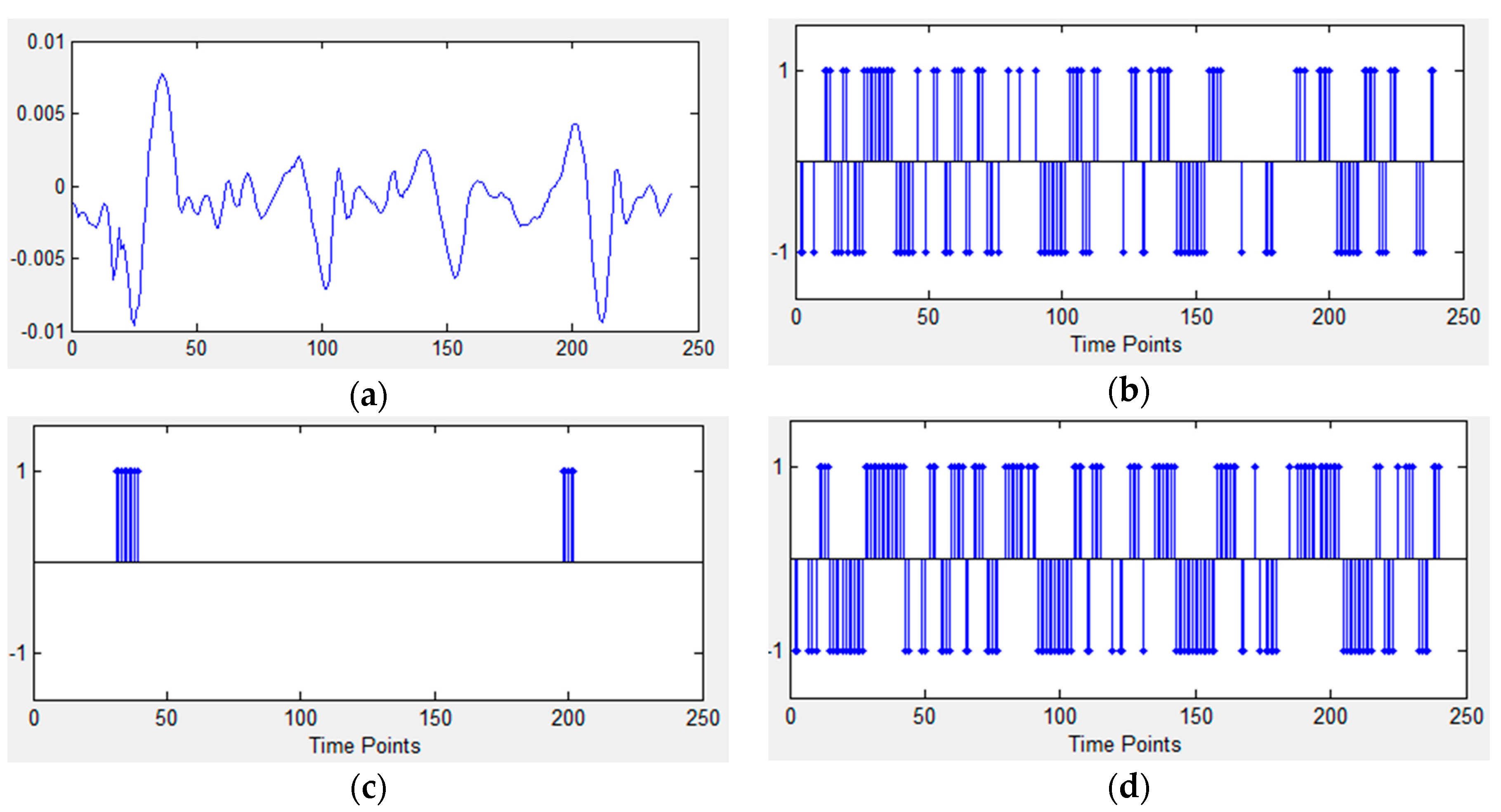
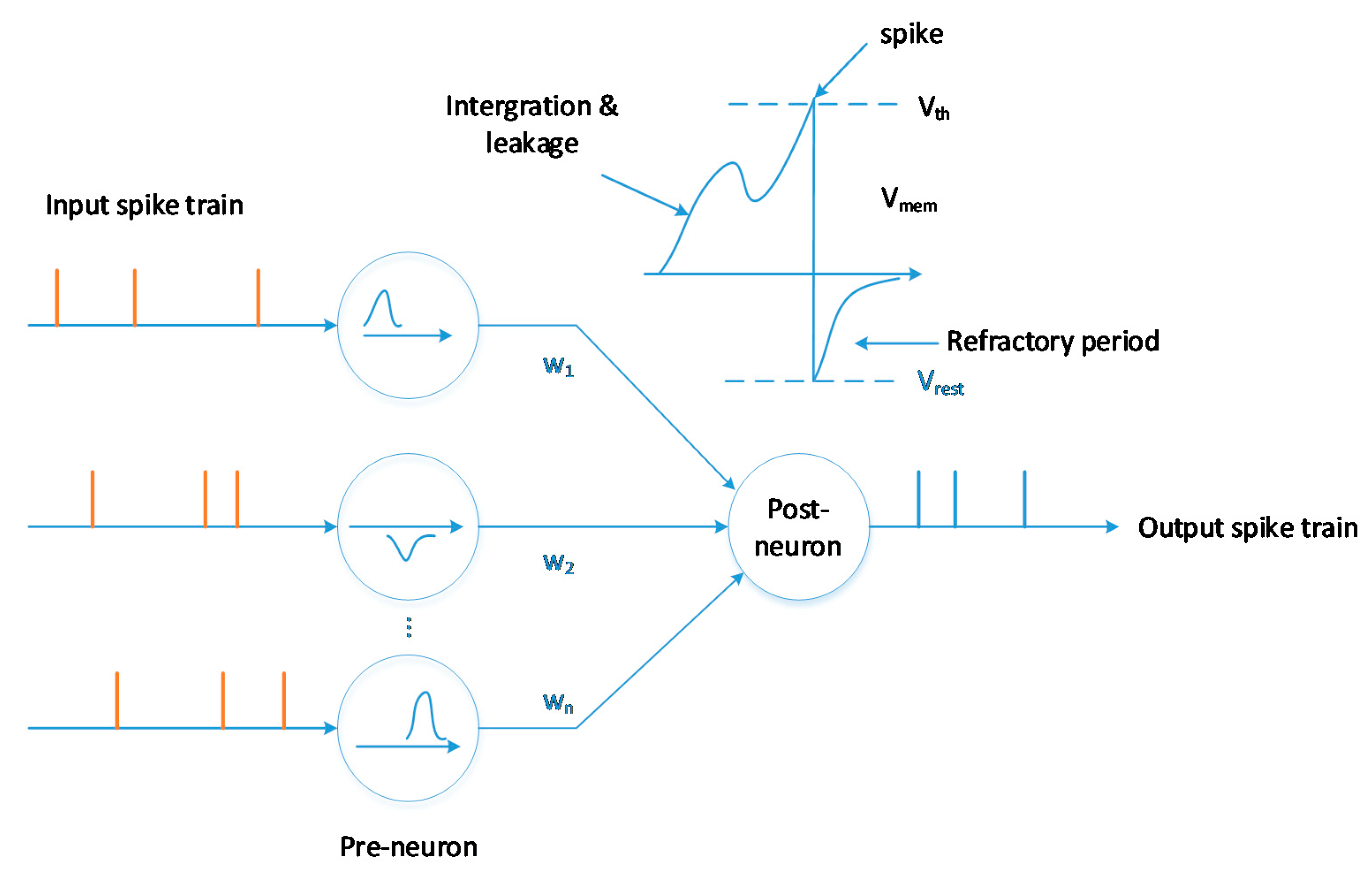
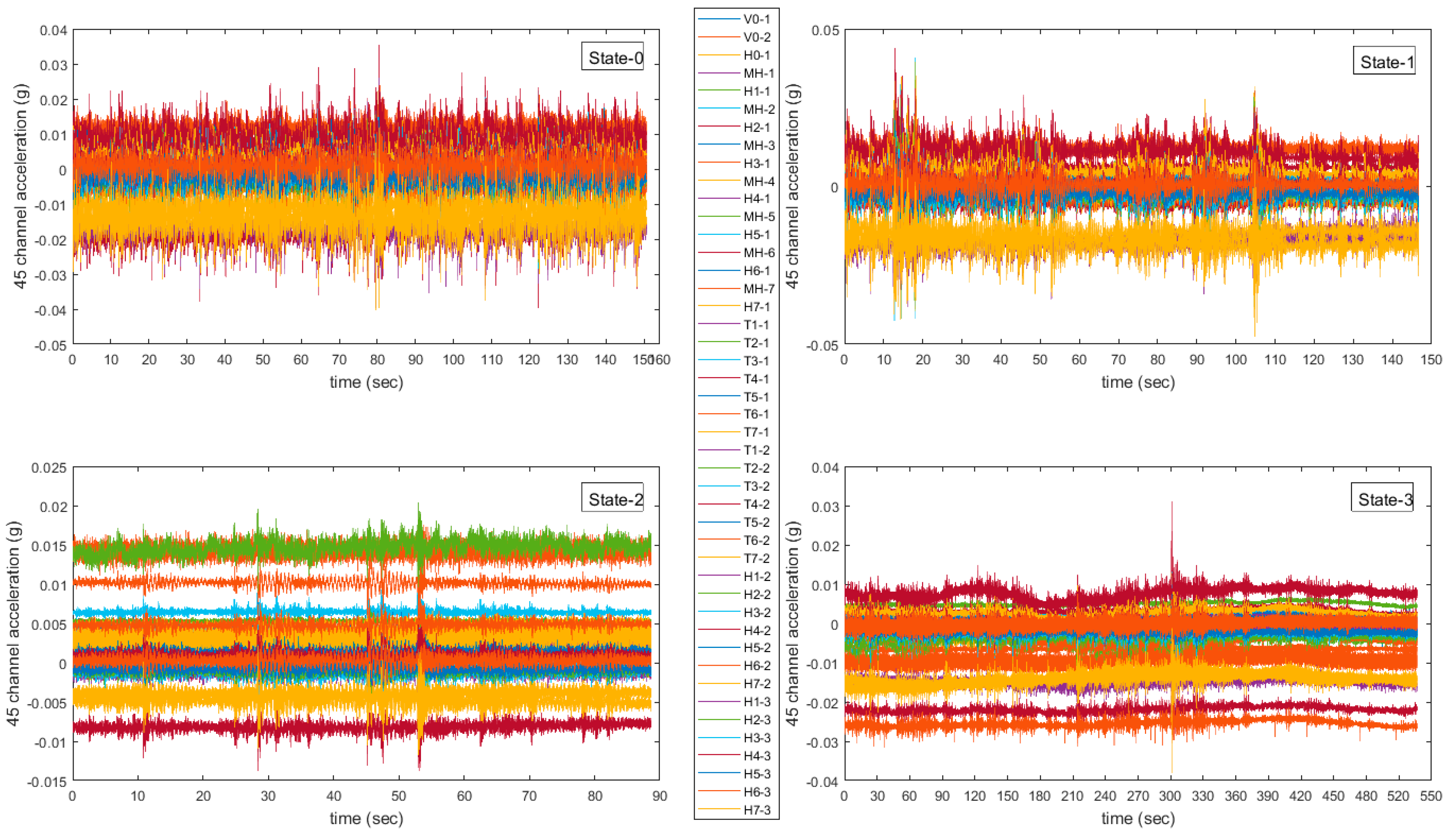
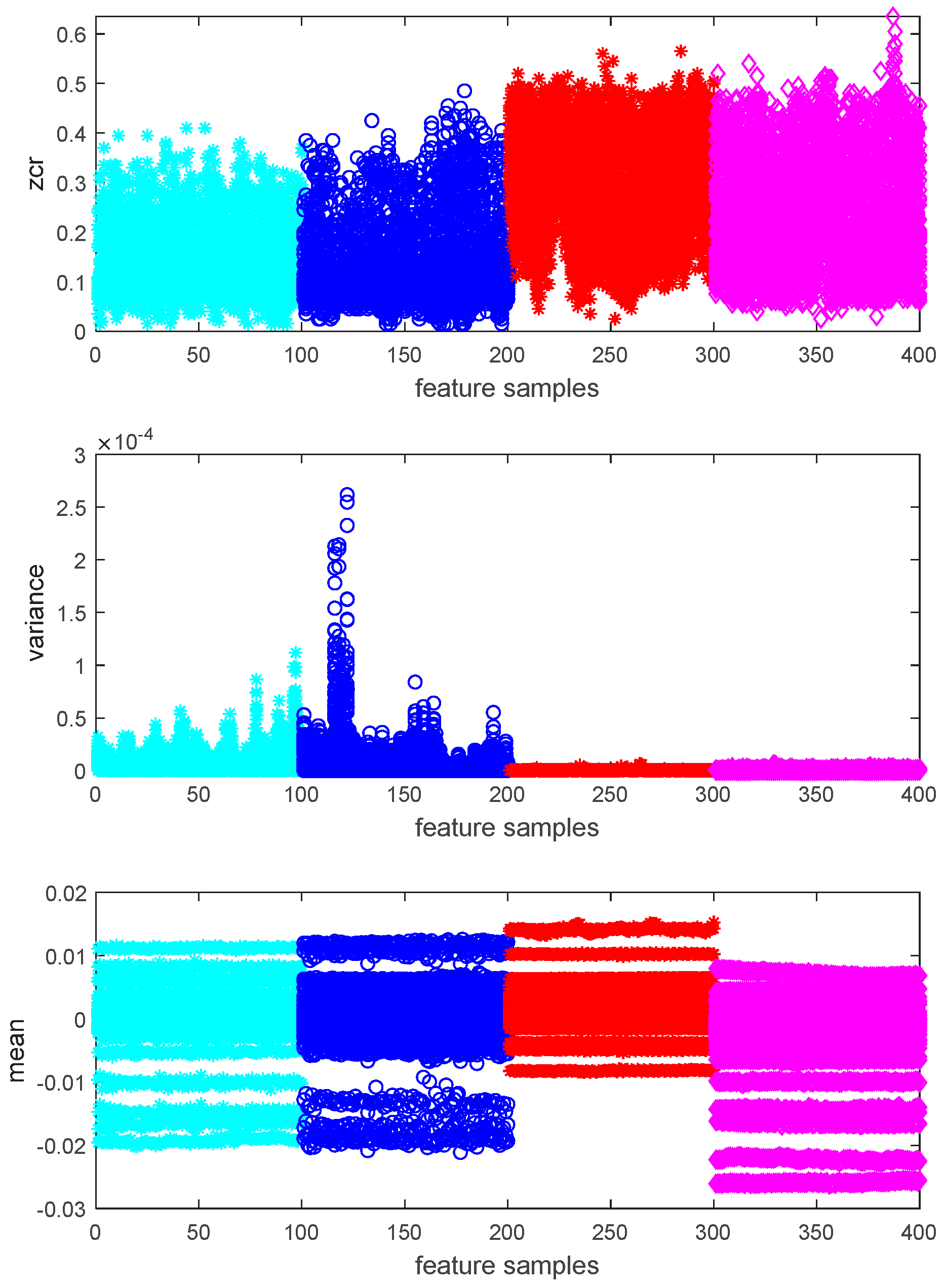
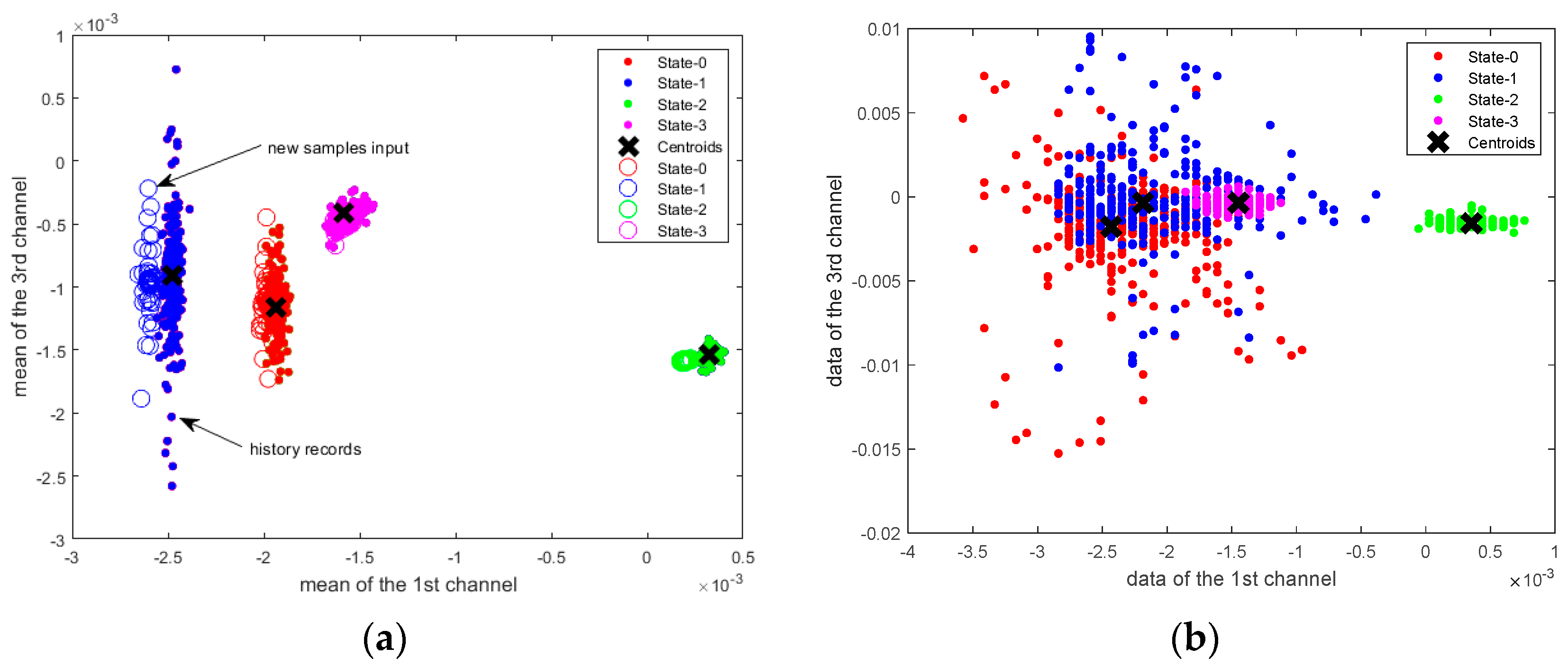

| Damage State | Description |
|---|---|
| State-0 | 8 min white noise base excitation process & 3 min ambient vibration |
| State-1 | After the 1st earthquake excitation, with 8 min white noise base excitation process & 3 min ambient vibration |
| State-2 | After the 2nd earthquake excitation, with 8 min white noise base excitation process & 3 min ambient vibration |
| State-3 | After the 3rd earthquake excitation, with 8 min white noise base excitation process & 3 min ambient vibration |
| Parameters Setting | Cluster Number | Distance | Initial Centroid Positions | Replicates |
| 4 | L1 distance | Random | 8 |
| Predict Label | State-0 | State-1 | State-2 | State-3 | |
|---|---|---|---|---|---|
| True Label | |||||
| (a) Mean samples | |||||
| State-0 | 100% | 0.0% | 0.0% | 0.0% | |
| State-1 | 0.0% | 100% | 0.0% | 0.0% | |
| State-2 | 0.0% | 0.0% | 100% | 0.0% | |
| State-3 | 0.0% | 0.0% | 0.0% | 100% | |
| (b) Raw data | |||||
| State-0 | 99.7% | 0.3% | 0.0% | 0.0% | |
| State-1 | 0.9% | 99.1% | 0.0% | 0.0% | |
| State-2 | 0.0% | 0.0% | 100% | 0.0% | |
| State-3 | 0.0% | 0.0% | 0.0% | 100% | |
| Parameter | Description | Value | |
|---|---|---|---|
| STDP Rate | Defines the learning rate of the STDP learning | 0.01 | |
| Firing threshold | Defines the threshold membrane potential beyond which the neuron fires a spike. | 0.5 | |
| deSNN Classifier Parameters | Mod | The weight is calculated as a modulation factor (the variable mod) to the power of the order of the incoming spikes. | 0.55–0.6 |
| Drift | Initial connection weights are further modified to reflect the following spikes, using a drift parameter. | 0.015 | |
| Damage State | Accuracy |
|---|---|
| State-0 | 100% |
| State-1 | 100% |
| State-2 | 100% |
| State-3 | 98.08% |
| Network. | Topology | Multiplier of Synapses | Total Neurons | Total Synapses |
|---|---|---|---|---|
| SNN | [45:10:1] | 10 | 56 | 460 |
| Area of Neurons | Area of Synapses | Area Overhead | Overall Accuracy | Number of Iterations |
| 5.04 × 10−4 mm2 | 1.10 × 10−3 mm2 | 1.61 × 10−3 mm2 | 99.18% | 2500 |
| 99.46% | 3000 |
| Damage State | SNN Output | Accuracy | |
|---|---|---|---|
| State-0 | 16 | 100% | 100% |
| State-1 | 18 | 95.67% | 97% |
| State-2 | 20 | 100% | 100% |
| State-3 | 22 | 99.8% | 99.9% |
| Overall accuracy | 99.18% | 99.46% | |
| Method | Classification Accuracy | Technology | Hardware Area | |
|---|---|---|---|---|
| Raw Data | Feature | |||
| K-means | 80% | 100% | TSMC 90 nm | 1.23 mm2~3.46 mm2 |
| ANN | 99.8% | 100% | CMOS 45 nm | 1.347 mm2 (neurons only) |
| SNN | 98.9% | 99.46% | CMOS 90 nm | 4.655 × 10−3 mm2 (NeuCube) |
| 1.61 × 10−3 mm2 (Customized SNN) | ||||
| Method | Sensitivity | Specificity |
|---|---|---|
| K-means | 92.97% | 73.87% |
| ANN | 99.94% | 99.15% |
| SNN | 100% | 100% |
© 2020 by the authors. Licensee MDPI, Basel, Switzerland. This article is an open access article distributed under the terms and conditions of the Creative Commons Attribution (CC BY) license (http://creativecommons.org/licenses/by/4.0/).
Share and Cite
Pang, L.; Liu, J.; Harkin, J.; Martin, G.; McElholm, M.; Javed, A.; McDaid, L. Case Study—Spiking Neural Network Hardware System for Structural Health Monitoring. Sensors 2020, 20, 5126. https://doi.org/10.3390/s20185126
Pang L, Liu J, Harkin J, Martin G, McElholm M, Javed A, McDaid L. Case Study—Spiking Neural Network Hardware System for Structural Health Monitoring. Sensors. 2020; 20(18):5126. https://doi.org/10.3390/s20185126
Chicago/Turabian StylePang, Lili, Junxiu Liu, Jim Harkin, George Martin, Malachy McElholm, Aqib Javed, and Liam McDaid. 2020. "Case Study—Spiking Neural Network Hardware System for Structural Health Monitoring" Sensors 20, no. 18: 5126. https://doi.org/10.3390/s20185126
APA StylePang, L., Liu, J., Harkin, J., Martin, G., McElholm, M., Javed, A., & McDaid, L. (2020). Case Study—Spiking Neural Network Hardware System for Structural Health Monitoring. Sensors, 20(18), 5126. https://doi.org/10.3390/s20185126






